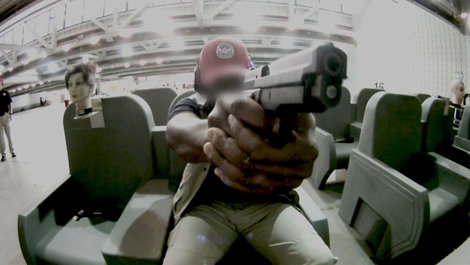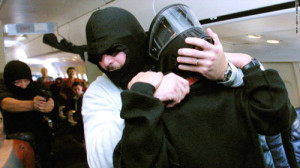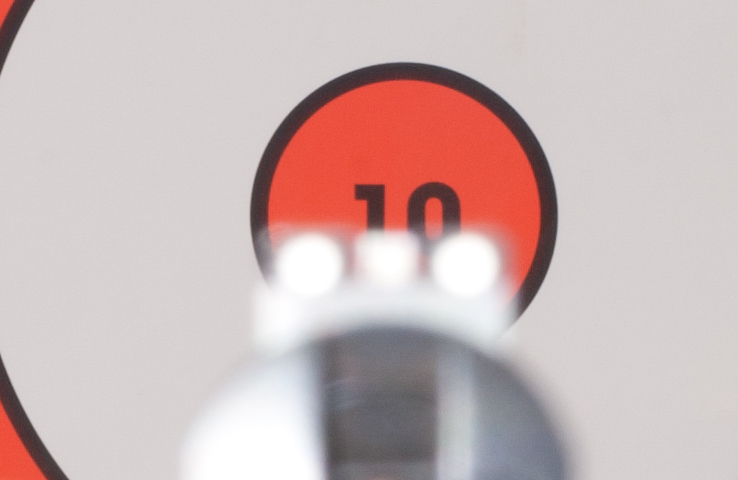Riding Shotgun In War On Drugs
[su_heading size=”30″]Special Enforcement Teams Go Undercover To Stem Tide Of Heroin Trafficking Across America[/su_heading]
STORY AND PHOTOGRAPHS BY TROY TAYSOM
[su_dropcap style=”light” size=”5″]I [/su_dropcap]finally got the call.
“How fast can you get here?” Sgt. Santiago asked.
“Five minutes,” I said.
“Good. We have eyes on our guy, and we are a go.”
I drove as fast as I could to the designated rally area, where I joined more than a dozen men, many with beards (some fairly long) and long hair. None looked remotely like stereotypical cops, but all were “kitted up” and ready to go.
The group packed an impressive assortment of firearms, from MP5s, M4s and a Remington 870 to Glock 17s and a few high-end 1911s (one I recognized as an Ed Brown custom job). All of the guys were wearing body armor with rifle plates, and some had added ballistic helmets. There was no joking or laughing in the ranks.
Several team members eyed me with suspicion, and for good reason. I was being allowed to witness what most citizens will never see: the inner workings of an active special enforcement team (SET). These select groups of undercover detectives are tasked with gathering solid intelligence on drug activity to target drug dealers and users for criminal prosecution. In the case of some users, this insider knowledge will prepare them to become confidential informants.
I asked permission before taking any recognizable pictures, but despite promising anonymity to the officers and their department for the sake of the mission and their security, several politely declined. Detective Blue, however, let me snap several pictures, and even smiled for a few. Others seemed to merely tolerate my presence, strategically turning their backs each time I raised my camera. But I understood. In an environment such as this, trust must be earned.
The cops assembled for this specific raid were a mix of SET teams from the city and county, and included detectives and special weapons and tactics (SWAT) members. High-tech equipment was already in place to monitor the targeted home in full high definition, so Sgt. Santiago would know if anyone attempted to enter or exit the house.
After a short drive, we reached our destination. The cops exited their vehicles with lightning speed, knowing exactly where they were going and who they were looking for. They were executing a rare “no-knock” search warrant, which exempted them from having to announce their presence prior to entering. The occupants had no idea that the hammer of justice was on its way.

The suspects were known heroin dealers, and in a city still reeling from four recent fatal overdoses, including a one-year-old baby who got into its parents’ stash, the mission had taken on even more urgency.
As the team swiftly mounted the stairs in a flurry of motion, chaos appeared to take over, but appearances can be misleading. This mission was anything but chaotic to these professionals. In a moment, the door was demolished, and a well-orchestrated group movement was quickly executed, one that could have made a dance company jealous.
Within minutes, the targeted suspects were in custody, and the “all-clear” was given. No shots had been fired, and no one had been hurt. Perhaps most importantly, some very dangerous people were led away in silver friendship bracelets to be questioned prior to being booked into the county jail.
A TOUGH BATTLE
All across the country, SET detectives such as these are fighting a battle that is nearly impossible to win. It’s not a thankless job, but it can sometimes feel like it. For every dealer arrested, dozens more are waiting in the wings to take over. There is no shortage of people willing to sell dope to our families and children, and there seems to be no shortage of family members and children willing to buy.
“There’s a heroin tsunami coming,” one department captain told me. “It’s going to get much worse in the very near future.”
Following the raid, the adrenaline rush of the raid may have been over, but the real police work was just getting started. Any search for drugs and their accouterments is a tedious, time-consuming, messy and occasionally gross task. But these veterans have seen drugs hidden in all kinds of places, including shower-curtain rods and freezers, under mattresses, behind medicine cabinets, in heat registers on the floor, even inside kids’ rooms and toys. On this particular search, the SET team even took a fire extinguisher outside to make sure it was what it appeared to be. No stone or piece of furniture goes unturned.
Users and dealers also hide drugs on their person. There are places on and in the human body where people are willing to hide drugs, and more than one person has died from an overdose using these foolish methods.

Once the evidence is collected, documented and bagged, it’s taken to a central evidentiary holding facility to be entered into computer system, ensuring a strong chain of custody.
This is the work life of a SET detective: observe, plan, observe some more, plan some more and chase what, at times, feels like phantom drug dealers.
DRUG OF CHOICE
The city where I’m embedded with this SET team is the embodiment of small-town America, but it is also a place where heroin has become the drug of choice, pushing meth and crack out of the way. Heroin makes its way into the U.S. primarily across our southern border, and many experts feel the opiate epidemic can be directly connected to opioid pills and the way they were marketed in the 1990s.
At one time, physicians were told that less than 1 percent of people who take opiates become addicted. According to author Sam Quinones in Dreamland: The True Tale of America’s Opiate Epidemic, Oxycontin was originally marketed by Purdue Pharma as a drug that was “virtually non-addictive.”
The drug cartels we read about or see on television are our neighbors. They are smart and well organized, making the SET detectives’ job even more difficult. Pursuing and investigating these businessmen and their businesses could be described as a high-stakes game of three-card monte, with the dopers dealing the cards. But this SET team continues the fight, always with hope that just one break will help stem the heroin overdoses that seem to have permeated the community.
Most of the heroin in this small town is a variety known as Mexican black tar. Cultivated and processed on the Pacific Coast of Mexico, black tar is rolled and manipulated into tiny balls, and then inserted into balloons. The least processed variety of heroin, because of its purity it is the most lethal. Depending on the region of the country, a black tar balloon will cost $10 to $30, and can keep an addict high for a few days.
Compared to opioid pain pills that can cost $1 per milligram on the street, heroin is a deal.
ANOTHER DAY, ANOTHER DEALER
Not long after returning to the office following the raid, Detective Noble, one of the senior SET detectives, received a call from an informant. A lady was looking to sell some meth, but the deal had to take place within 15 minutes. The office quickly turned into a beehive. Noble got into a buy car, an undercover vehicle only used for undercover drug deals, while the rest of us drove to different locations to set up a perimeter around the meeting point.

During the set-up, the dealer kept changing the location in hopes of ensuring that her client wasn’t a cop. I was out on the perimeter with Sgt. Santiago, listening via a receiver to what was happening inside the buy car.
Finally, the dealer approached Noble’s car and got in. She sold him 4 grams of meth for $120, but wouldn’t sell him the two balloons of heroin she had hidden on her person. When the take-down signal was given, all officers converged on the dealer as she exited Noble’s car right in front of her house.
The look on her face was priceless. She denied having sold drugs until Sgt. Santiago explained that the man in the car was a cop, and that we had heard the entire deal. Since she was on probation for other drug offenses, the team called her probation officer, who came out and helped with the search. The search yielded Oxycontin, morphine, Clonidine, meth, heroin and Oxycodone, and other pills and paraphernalia were collected and bagged as evidence.
A TEAM OF INDIVIDUALS
Later, I had the opportunity to speak with several members of the team, including Detective Polaris, who surprised me with his candidness and honesty.
“I’m not here to make enemies,” he told me. “I’d rather make friends. These people are going through tough times, and they need to know that someone cares. It doesn’t mean I won’t take them to jail. Sometimes that’s what they need, but my hope is that they find a way out of the drug life.”
Detective Polaris relayed a story, with tears in his eyes, of saving a woman’s life as she tried to commit suicide. The woman had a three-month-old baby, and was able to see and hold her infant once she was safe and in the hospital. According to Polaris, the baby just stared and smiled at him and his rookie partner. The woman still calls Polaris to this day to thank him, and to provide an update on her life. “This is why I became a cop,” he tells me.
Detective Puller has been an officer for five years, and has been with SET for six months. A former active-duty Marine and now in the Army Reserve, discipline and service are his go-to attributes. He has a kind demeanor and a disarming smile. These qualities provide a unique ability to make suspects feel comfortable, and comfortable people talk.
The newest member of SET, Detective Gigante is a quick study in the art of interviewing a suspect. I watched him interview one on the street, and his calm demeanor kept the young lady talking until she had reached the point of no return. Gigante calmly showed her his phone and asked, “How do you think I got these texts?” The game was up, and the girl is now in the process of becoming a confidential informant.
Others are more reserved and quiet. Detective Noble, who looks much younger than he is, tends to keep to himself. He’ll make small talk, but isn’t much on being interviewed. But you know that under his quiet exterior is a brain constantly at work, figuring out how to stay ahead of his targets.

Sgt. Santiago is the “old man” of the bunch. He’s been a cop for more than 20 years, but remains in good physical shape and is a solid leader for his young group of detectives. There are no short cuts allowed on his team, and each process is done the right way. This includes everything from the way probable cause is acquired and writing search warrants to the gear he requires them to wear in the field. He expects his men to wear full-body armor including ballistic helmets when entering a house for a variety of reasons, including one that is very personal.
“I hate delivering death notices,” he confided. “And I refuse to deliver a death notice to the wife of one of my detectives because I let them forgo wearing their protective gear. The gear isn’t a 100 percent guarantee [on safety], but I won’t allow my guys to take that chance. There is no leeway or negotiation on this point.”
The years of working SET and other drug task-force assignments have taken a toll on Santiago. He has grown tired of seeing the worst that mankind has to offer. He would love nothing more than to open a beachside bar in the Caribbean, where he could make mojitos and scuba dive for the rest of his life. But that second career will have to wait. He still has a lot of police work left in him.
Other than Santiago, each SET detective will return to regular patrol after the four-year stint on the team is up. This way, the SET squad gets to train more officers on the ins and outs of the drug epidemic that continues to plague every city in this country.

Just because you haven’t seen the problem first-hand doesn’t mean it does not exist. The opiate epidemic is growing worse by the day, with no end in sight. But thanks to leaders such as Sgt. Santiago and his dedicated team duplicated on police forces across the nation, it is a battle that will continue to be fought with commitment, knowledge and bravery. ASJ
Editor’s note: The names of the officers in this story have been changed to protect their location and identity.



